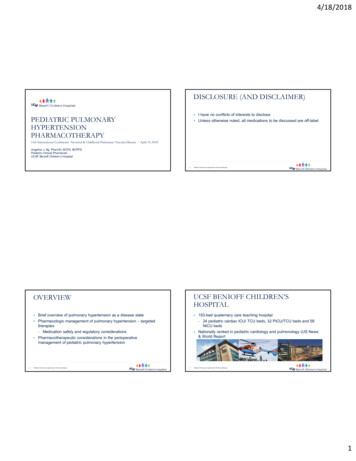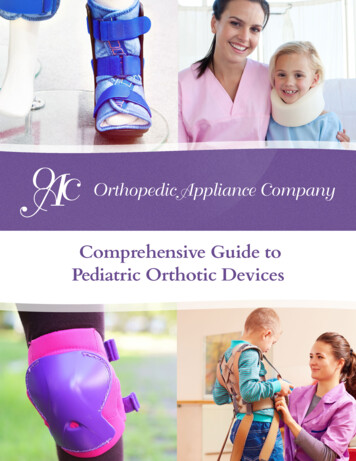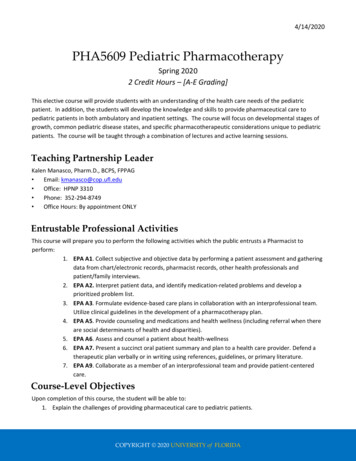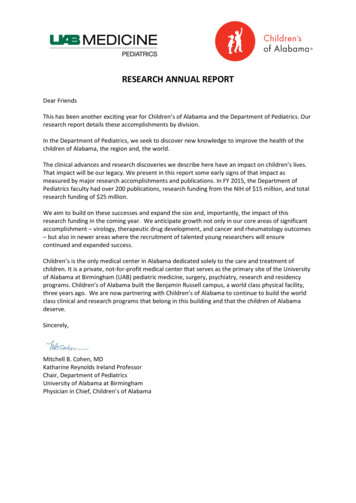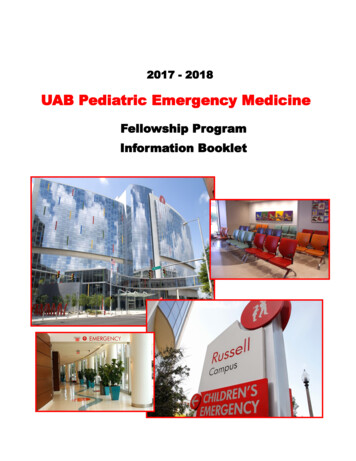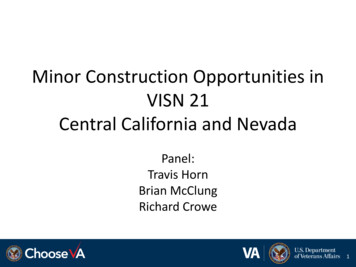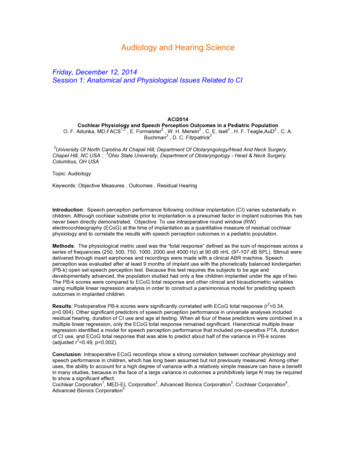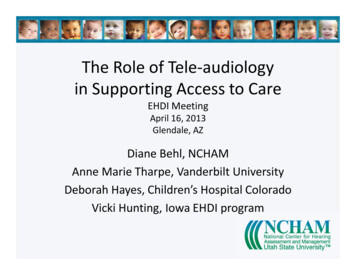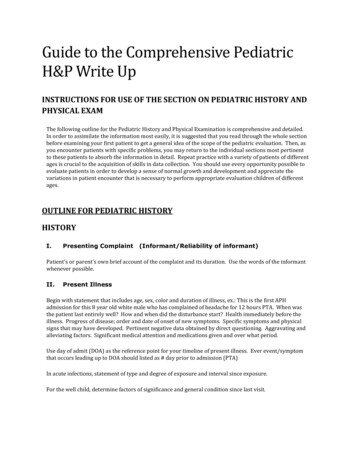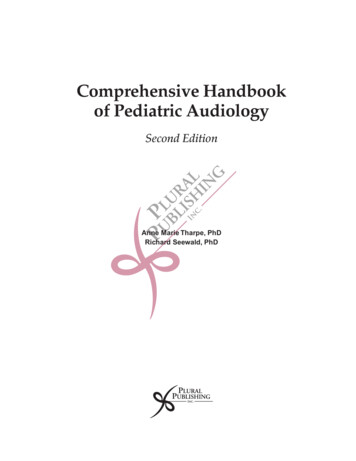
Transcription
Comprehensive Handbookof Pediatric AudiologySecond EditionAnne Marie Tharpe, PhDRichard Seewald, PhD
ContentsForeword by Fred H. Bess, PhDAcknowledgmentsContributorsixxixiiiITypical Auditory Development11Hearing Development: Embryology of the EarMark Hill32Biologic Development of the Auditory System From Periphery to CortexRobert V. Harrison233Infant Speech PerceptionDerek M. Houston494Auditory Development in Children With Normal HearingLynne A. Werner and Lori J. Leibold67IIEtiology and Medical Considerations875Descriptive Epidemiology of Childhood Hearing ImpairmentAdrian Davis and Katrina A.S. Davis896Genetics of Childhood Hearing LossLinda J. Hood and Bronya J.B. Keats1337Medical Considerations for Infants and Young Children With Hearing Loss:A Pediatrician’s PerspectiveBetty R. Vohr1498Medical Considerations for Infants and Children With Hearing Loss:An Otologist’s PerspectiveCraig A. Buchman and Oliver F. Adunka1639Current Issues in Preventable Hearing LossAndrea Hillock-Dunn and Christopher Spankovich181v
viComprehensive Handbook of Pediatric AudiologyIIITypes of Hearing Loss in Children20510Conductive Hearing Loss in Children: Otitis Media With Effusion andCongenital ConditionsLisa L. Hunter and Daniel I. Choo20711Auditory Neuropathy Spectrum DisorderGary Rance and Arnold Starr22712Management of Children With Auditory Neuropathy Spectrum Disorder (ANSD)Patricia A. Roush24713(Central) Auditory Processing Disorders in ChildrenPrudence Allen26914Pseudohypacusis: False and Exaggerated Hearing LossJames E. Peck295IVEarly Identification of Hearing Loss30715Principles and Methods of Newborn Hearing ScreeningMartyn Hyde30916Newborn Hearing Screening Program Evaluation and QualityMartyn Hyde34917Screening for Hearing Loss and Middle Ear Disorders: Beyond the Newborn PeriodJackson Roush and Nicole E. Corbin38318Newborn Hearing Screening Program Implementation: Early Hearing Detectionand InterventionKathryn L. Beauchaine, Jeffrey K. Hoffman, and Diane L. Sabo413VAudiologic Assessment of Children44719Middle Ear MeasurementLisa L. Hunter and Chelsea M. Blankenship44920Otoacoustic Emissions in Infants and Children: An Updated ApproachCarolina Abdala, Margaret Winter, and Christopher A. Shera47521Threshold Assessment in Infants Using the Frequency-SpecificAuditory Brainstem Response and Auditory Steady-State ResponseSusan A. Small and David R. Stapells505
Contents22Electrophysiological Assessment of Hearing With Auditory Middle Latency andAuditory Late ResponsesJames W. Hall III and Anuradha R. Bantwal55123Behavioral Audiometry in Infants and ChildrenAllan O. Diefendorf and Anne Marie Tharpe59124Audiologic Considerations for Children With Complex Developmental ConditionsAllan O. Diefendorf, Kathleen R. Corbin, Rebecca Trepcos-Klingler, and Amanda S. Weinzierl609VIHearing Technologies62925Current Approaches to the Fitting of Amplification to Infants and Young ChildrenMarlene P. Bagatto and Susan D. Scollie63126Hearing Instrument Orientation for Children and Their FamiliesAnne Marie Tharpe, Hollea A.M. Ryan, and Samantha J. Gustafson65927Remote Microphone Systems and Communication Access for ChildrenJace Wolfe, Dawna Lewis, and Leisha R. Eiten67728Measuring Outcomes of Infants and Children With Hearing LossTeresa Y.C. Ching, Sanna Y.L. Hou, and Vicky W. Zhang71329Cochlear Implants for Children: Promoting Auditory Development WithElectrical PulsesKaren A. Gordon73930Care of Children Who Use Cochlear ImplantsMarilyn Neault76131Other Hearing Devices: Bone ConductionBill Hodgetts78132The Future of Auditory ImplantsRené H. Gifford793VIIManagement of Childhood Hearing Loss81333History of the Management of Hearing Loss in ChildrenAndrée Durieux-Smith and Elizabeth M. Fitzpatrick81534Facilitating Communication in Infants and Toddlers With Hearing LossMelody Harrison829vii
viii Comprehensive Handbook of Pediatric Audiology35Potential Meets Reality in Early Intervention for Children With Hearing LossAmy McConkey Robbins84936Support for Adolescents With Hearing LossKris English87137Minimal Hearing Loss in ChildrenHeather Porter, Fred H. Bess, and Anne Marie Tharpe88738Moderate to Profound Sensory/Neural Hearing Loss in ChildrenKaren C. Johnson, Amy S. Martinez, Laurie S. Eisenberg, and Dianne M. Hammes Ganguly91539School-Age ChildrenCarolyne Edwards94140Providing Services in Educational Contexts: Defining the Role of theEducational AudiologistPatricia M. Chute and Mary Ellen Nevins961Index973
ForewordIt is difficult to pinpoint when the term pediatric audiology actually came into common usage. We can onlyassume that the concept of pediatric audiology beganshortly after the development of the discipline of audiology during and following World War II. We do knowthat Canfield, an otolaryngologist from Yale University,made one of the earliest references to pediatric audiology in his seminal book Audiology, The Science of Hearing (1949). However, long before the 1940s, historicalwritings clearly show that early civilization experienced and appreciated the problems associated withdeafness in childhood. Indeed, Greek and Latin writersreferenced the plight of the deaf on several occasionsin the Bible.During the Renaissance through to the latter partof the 19th century, we read about teachers and priestswho were dedicated to serving children with hearingloss. This was a period in deaf education sometimesreferred to as “the age of teaching”; it was an era inwhich the oral method clashed with teachings thatemphasized the use of signs and finger spelling. Suchwell-recognized teachers as Pedro Ponce de León andJuan Pablo Bonet of Spain, Samuel Heinicke of Germany, Abbe Charles Michel de l’Epee of France, andThomas Braidwood of Scotland were early pioneersof methods and techniques for educating young deafchildren. One well-known scholar who brought specific teaching methods and philosophies from Europeto America was Thomas Gallaudet. After studying withde L’Epee in Paris, Gallaudet returned to the UnitedStates and established the first school for deaf childrenin Hartford, Connecticut, in 1817. The school was calledthe American Asylum for the Education and Instruction of the Deaf and Dumb.During the early 20th century, pediatric audiologywas not yet a recognized specialty, but educational andhealth care professionals throughout the United Statesbecame involved by necessity in the identification,assessment, and management of very young childrenwith hearing loss. Perhaps most notable was the workof Sir Alexander and Lady Irene Ewing who workedtirelessly to serve young children with hearing loss inGreat Britain. As early as 1919, Irene Ewing opened ahearing clinic at Manchester University. The Ewings,more than anyone during this period, influenced professionals throughout the world on issues pertainingto the identification and management of childhooddeafness. They introduced some of the fundamentalconcepts now associated with pediatric audiology:the benefits of early identification and interventionincluding hearing aids, the importance of parent-hometraining for the development of speech and language,and the effective approaches for testing young children with hearing loss. By most accounts, this was thebeginning of pediatric audiology.By the late 1950s and early 1960s, a small groupof audiologists was beginning to focus its efforts onyoung children, and we began to hear the term pediatric audiology on a more frequent basis; soon thereafter,training programs started to offer specialty tracks inpediatric audiology. There were few books dedicatedto young children with hearing loss. As there wasno single text that met the specific needs of pediatricaudiologists or university training programs, severalresource books were considered essential reading.These books included Educational Guidance and the DeafChild (Ewing, 1957), and New Opportunities for Deaf Children by Sir Alexander Ewing (1959); Auditory Disordersin Children by Myklebust (1954); Deafness in Childhoodby McConnell and Ward (1967); and Hearing and Deafness by Davis and Silverman (1960).Clinical protocols related to identification, assessment, and hearing aid fitting for very young childrenalso was limited. Evidence-based procedures had notyet been developed, and clinicians working with children were forced to rely mostly on intuition and common sense for their clinical decision making — clinicalpractice was probably more art than science. As Lidenand Harford (1985) observed, pediatric audiologists“waved their magic wand and sprinkled whiffle dustto make the child’s invisible reactions visible” (p. 6).Importantly, robust clinical tools commonly used today,such as electroacoustic immittance measures, auditorybrainstem responses, and otoacoustic emissions, werenot yet available to pediatric audiologists for the identification, assessment, and management of childrenwith hearing loss. Although the profession of audiology recognized the importance of early identificationix
xComprehensive Handbook of Pediatric Audiologyof hearing loss in children, the average age of identification in the United States was 3 to 4 years, and therewas a significant lag between the age when a child wasidentified and the age when a child actually receiveda hearing aid. Hearing aids were large, unattractive,and produced a great deal of distortion. Receiver buttons were used to modify the electroacoustic responsesof hearing aids, and Y-cords served to provide a childwith bilateral amplification. Hearing aid fitting wasaccomplished using a comparative approach for aidedsound-field behavioral thresholds. The hearing aidthat provided the most threshold improvement withthe least amount of irregularity across frequencies wasthought to provide the best speech understanding andsubsequently was the hearing aid of choice. Because itwas difficult to obtain accurate thresholds on youngchildren using behavioral methodology, the fitting strategy was an ongoing process sometimes taking morethan a year to finalize.The contents of this new edition (second) of Comprehensive Handbook of Pediatric Audiology, serve asa stunning reminder of how far we have come sincethose early years in our efforts to serve young childrenwith hearing loss and their families. Indeed, one cannothelp but be impressed with the many positive changesthat have occurred since the first edition of this book.Today, better graduate education, advanced technology, and innovative clinical research have broughtabout significant improvements in early identificationof hearing loss, audiological assessment, the selectionand evaluation of amplification, and the managementstrategies used with young deaf children. We now havethe ability to identify hearing loss in the vast majorityof newborns, obtain reliable frequency-specific threshold information on infants and toddlers, and objectively fit young babies with digital hearing aids andother assistive devices. The advent of cochlear implantation has resulted in significant improvements in thespeech, language, and listening skills of children withsevere-to-profound bilateral sensorineural hearingloss. We also have witnessed improvements in technology and medical care that have brought about changesin the prevalence of causation and severity of hearingloss. The second edition of Comprehensive Handbook ofPediatric Audiology addresses all of the relevant issuesimpacting today’s young children with hearing lossand their families. It is exciting to see in one volumecomprehensive coverage of contemporary trends inpediatric audiology. No doubt, the information contained within this new edition will be of value to thosewho seek to better understand the perplexities of childhood deafness and motivate others to search for newerand better ways to serve young children with deafness.A portion of the proceeds from this book will bededicated to a student scholarship fund at VanderbiltUniversity named in memory of Judith S. Gravel, anoutstanding alumna of Vanderbilt University and oneof the true giants of pediatric audiology. In fact, it wasJudy Gravel who originally envisioned the need for abook in audiology that focused on pediatric hearingloss. Her presence can be seen throughout the entiretyof this book simply by reviewing the references at theend of each chapter that highlight her diversity of interest areas and contributions to the profession. AlthoughJudy was taken from us at a young age, her life wasfilled with love, fun, and accomplishments that farexceeded her years. To be sure, we are all so very fortunate that she shared her many gifts with us.— Fred H. Bess, PhDReferencesCanfield, N. (1949). Audiology: The science of hearing —A developing professional specialty. Springfield, IL: CharlesC. Thompson.Davis, H., & Silverman, S. R. (1960). Hearing and deafness. NewYork, NY: Holt, Rinehart and Winston.Ewing, A.W.G. (1957). Educational guidance and the deaf child.Manchester, UK: Manchester University Press.Ewing, A.W.G. (1959). New opportunities for deaf children. Manchester, UK: Manchester University Press.Liden, G., & Harford, E. R. (1985). The pediatric audiologist:From magician to clinician. Ear and Hearing, 6(1), 6–9.McConnell, F., & Ward, P. H. (Eds.). (1967). Deafness in childhood. Nashville, TN: Vanderbilt University Press.Myklebust, H. (1954). Auditory disorders in children: A manualfor differential diagnosis. New York, NY: Grune and Stratton.
Acknowledgmentsthroughout this journey we have always had the support, expertise, and patience of the exceptional group atPlural Publishing. Specifically, we would like to thankAngie Singh for her genuine encouragement and support from the very start. Throughout the process, Valerie Johns, Kalie Koscielak, and Nicole Bowman havealways been there to nudge us along gently and to helpus with even the smallest editorial detail. We cannotimagine having a more positive and informed groupwith whom to work.We offer a special thank you to Samantha Gustafson.Her amazing organizational skills, and overall management of the editing process kept us on track for the lastyear and a half. We simply could not have done it without her! We are also grateful to Melanie Jordan who tookon the tremendous task of verifying thousands of references for us. And, of course, we would like to thank the68 authors who took time from their research, clinical,and administrative activities to share their knowledge,experiences, and wisdom with the readers of this volume.Finally, we would like to thank our life partnersJim and Carol for their unqualified support of our workon this project — we promise to make up for lost time!The concept and original outline for this book weredeveloped at a meeting with Dr. Judith Gravel in July2006. Judy was a big dreamer and saw a great need fora comprehensive text in the area of pediatric audiology.With a twinkle in her eye, she referred to this book as“the mothership.” By the end of this meeting, the Tableof Contents included chapters covering every conceivable topic related to the basic sciences, screening,assessment, and management associated with childhood hearing and hearing loss. It was her vision andpassion that led to the development of this book. Twoweeks following the July 2006 meeting with Judy, shewas diagnosed with cancer. We lost Judy on December 31, 2008. Throughout her courageous battle withcancer, we asked Judy on numerous occasions if shewanted to continue the work on the book. Our querieswere always greeted with silence. When Judy becamesilent the answer was always clear. To discontinuework on this project was never an option for Judy. Wehave done all that we could to ensure this book lives upto Judy’s dream. We thank you, Judy.It is possible that our work on this book had moremissed deadlines than the book has pages. Nonetheless,— Anne Marie Tharpe and Richard Seewaldxi
ContributorsCarolina Abdala, PhDProfessorTina and Rick Caruso Department ofOtolaryngology-Head and Neck SurgeryKeck School of MedicineUniversity of Southern CaliforniaLos Angeles, CaliforniaChapter 20Ali Yavar Jung National Institute for the HearingHandicappedAudiologist and Speech-Language PathologistAURED — Aural Education for the HearingImpairedMumbai, IndiaChapter 22Oliver F. Adunka, MD, FACSProfessor and Division DirectorDepartment of Otolaryngology-Head and NeckSurgeryThe Ohio State University Wexner Medical CenterDirector, Pediatric OtologyNationwide Children’s HospitalColumbus, OhioChapter 8Prudence Allen, PhDDirectorNational Centre for AudiologyAssociate ProfessorSchool of Communication Sciences and DisordersFaculty of Health SciencesThe University of Western OntarioLondon, Ontario, CanadaChapter 13Marlene P. Bagatto, AuD, PhDAdjunct Research ProfessorNational Centre for AudiologyWestern UniversityLondon, Ontario, CanadaChapter 25Anuradha R. Bantwal, MSc (Audiology andSpeech Rehabilitation)Visiting FacultyKathryn L. Beauchaine, MA, CCC-AAudiology Coordinator, Hearing and BalanceCenterBoys Town National Research HospitalOmaha, NebraskaChapter 18Fred H. Bess, PhDVickie and Thomas Flood ProfessorDepartment of Hearing and Speech SciencesVanderbilt Bill Wilkerson CenterVanderbilt University School of MedicineDirectorNational Center for Childhood Deafness andFamily CommunicationNashville, TennesseeChapter 37Chelsea M. Blankenship, AuDPhD StudentUniversity of CincinnatiCincinnati, OhioChapter 19Craig A. Buchman, MD, FACSLindburg Professor and ChairDepartment of OtolaryngologyWashington University School of MedicineSt. Louis, MissouriChapter 8xiii
xiv Comprehensive Handbook of Pediatric AudiologyTeresa Y.C. Ching, PhDSenior Research ScientistTeam Leader for Rehabilitation ProceduresNational Acoustic LaboratoriesSydney, AustraliaChapter 28Daniel I. Choo, MD, FACS, FAAPProfessor and DirectorDivision of Pediatric Otolaryngology Head andNeck SurgeryCincinnati Children’s Hospital Medical CenterDepartment of Otolaryngology Head and NeckSurgeryUniversity of CincinnatiCincinnati, OhioChapter 10Patricia M. Chute, EdD, CCC-ADeanSchool of Health ProfessionsNew York Institute of TechnologyHealth Policy FellowOld Westbury, New YorkChapter 40London, United KingdomChapter 5Katrina A.S. Davis, MB, BChir, MRCPsychResearch AssociateDepartment of Psychological MedicineInstitute of Psychiatry, Psychology, andNeuroscienceKing’s College LondonLondon, United KingdomChapter 5Allan O. Diefendorf, PhDProfessor EmeritusIndiana University School of MedicineVisiting ProfessorButler UniversityIndianapolis, IndianaChapters 23 and 24Andrée Durieux-Smith, PhD, FCAHSProfessor EmeritusFaculty of Health SciencesUniversity of OttawaOttawa, Ontario, CanadaChapter 33Kathleen R. Corbin, MA, CCC-AAudiologistRiley Hospital for Children at Indiana UniversityHealthIndianapolis, IndianaChapter 24Carolyne Edwards, MCISc, MBADirector, Auditory Management ServicesExecutive Director and Senior FacultyGestalt Institute of TorontoToronto, Ontario, CanadaChapter 39Nicole E. Corbin, AuDDepartment of Allied Health SciencesDivision of Speech and Hearing SciencesUniversity of North Carolina School of MedicineChapel Hill, North CarolinaChapter 17Laurie S. Eisenberg, PhDProfessor of Research OtolaryngologyUSC Caruso Family Center for ChildhoodCommunicationTina and Rick Caruso Department ofOtolaryngology-Head and Neck SurgeryKeck School of MedicineUniversity of Southern CaliforniaLos Angeles, CaliforniaChapter 38Adrian Davis, OBE, FFPH, FSS, FRSA, PhDDirectorAD CAVE Solutions Ltd.Honorary Professor of Hearing andCommunicationUniversity College LondonLeisha R. Eiten, AuD, CCC-AClinical Coordinator
ContributorsBoys Town National Research HospitalOmaha, NebraskaChapter 27Kris English, PhDProfessor and Interim School DirectorSchool of Speech Pathology and AudiologyThe University of AkronAkron, OhioChapter 36Elizabeth M. Fitzpatrick, PhDAssociate ProfessorFaculty of Health SciencesUniversity of OttawaSenior ScientistChildren’s Hospital of Eastern Ontario ResearchInstituteOttawa, CanadaChapter 33Dianne M. Hammes Ganguly, MA, CCC-SLPAssistant Professor of Clinical OtolaryngologyUSC Caruso Family Center for ChildhoodCommunicationTina and Rick Caruso Department ofOtolaryngology-Head and Neck SurgeryKeck School of MedicineUniversity of Southern CaliforniaLos Angeles, CaliforniaChapter 38René H. Gifford, PhDAssociate Professor, Hearing and Speech SciencesDirector, Cochlear Implant ProgramAssociate Director, Implantable HearingTechnologiesVanderbilt Bill Wilkerson CenterNashville, TennesseeChapter 32Karen A. Gordon, PhD, Reg. CASPLO, CCC-ABastable-Potts Health Clinician Scientist inHearing ImpairmentArchie’s Cochlear Implant Laboratory, TheHospital for Sick ChildrenAssociate Professor, Department ofOtolaryngology-Head and Neck SurgeryUniversity of TorontoToronto, CanadaChapter 29Samantha J. Gustafson, AuDDepartment of Hearing and Speech SciencesVanderbilt Bill Wilkerson CenterVanderbilt University School of MedicineNashville, TennesseeChapter 26James W. Hall III, PhDProfessorOsborne College of AudiologySalus UniversityElkins Park, PAProfessorCollege of Communication Sciences and DisordersUniversity of HawaiiHonolulu, HIExtraordinary ProfessorDepartment of Audiology and Speech PathologyUniversity of PretoriaPretoria, South AfricaChapter 22Melody Harrison, PhD, CCC-SLPProfessorDivision of Speech and Hearing SciencesDepartment of Allied Health SciencesUniversity of North Carolina School of MedicineChapel Hill, North CarolinaChapter 34Robert V. Harrison, PhD, DScProfessor and Director of ResearchDepartment of Otolaryngology-Head and NeckSurgeryUniversity of TorontoSenior ScientistProgram in Neuroscience and Mental HealthThe Hospital for Sick ChildrenToronto, CanadaChapter 2xv
xvi Comprehensive Handbook of Pediatric AudiologyMark Hill, PhDHead of EmbryologySchool of Medical Sciences, MedicineUNSW AustraliaSydney, AustraliaChapter 1Nashville, TNHonorary ProfessorSchool of Health and Rehabilitation SciencesUniversity of QueenslandBrisbane, AustraliaChapter 6Andrea Hillock-Dunn, AuD, PhD, CCC-AAssistant ProfessorDepartment of Hearing and Speech SciencesVanderbilt UniversityAssociate DirectorDivision of Pediatric AudiologyVanderbilt Bill Wilkerson CenterNashville, TennesseeChapter 9Sanna Y.L. HouPaediatric Research AudiologistNational Acoustic LaboratoriesSydney, AustraliaChapter 28Bill Hodgetts, PhDAssociate ProfessorUniversity of AlbertaProgram Director, Bone ConductionAmplificationInstitute for Reconstructive Sciences inMedicineMisericordia HospitalEdmonton, CanadaChapter 31Jeffrey K. Hoffman, MS, CCC-AOutreach CoordinatorEarly Childhood Hearing Outreach (ECHO)InitiativeNCHAM — National Center for HearingAssessment and ManagementUtah State UniversityLogan, UtahChapter 18Linda J. Hood, PhDProfessorDepartment of Hearing and Speech SciencesAssociate Director for ResearchNational Center for Childhood DeafnessVanderbilt Bill Wilkerson CenterVanderbilt UniversityDerek M. Houston, PhDAssociate ProfessorDepartment of Otolaryngology-Head and NeckSurgeryThe Ohio State University College of MedicineColumbus, OhioChapter 3Lisa L. Hunter, PhDScientific Director, AudiologyCommunication Sciences Research CenterCincinnati Children’s Hospital Medical CenterProfessorOtolaryngology and Communication Sciencesand DisordersUniversity of CincinnatiCincinnati, OhioChapters 10 and 19Martyn Hyde, BSc, PhDProfessorDepartment of OtolaryngologyUniversity of TorontoConsultantBritish Columbia Early Hearing ProgramOntario Infant Hearing ProgramToronto, CanadaChapters 15 and 16Karen C. Johnson, PhDUSC Caruso Family Center for ChildhoodCommunication
Contributors xviiTina and Rick Caruso Department ofOtolaryngology-Head and Neck SurgeryKeck School of MedicineUniversity of Southern CaliforniaLos Angeles, CaliforniaChapter 38Bronya J.B. Keats, PhDProfessor and Head EmeritusDepartment of GeneticsLouisiana State University Health SciencesCenterNew Orleans, LouisianaChapter 6Lori J. Leibold, PhDDirector, Center for Hearing ResearchBoys Town National Research HospitalOmaha, NebraskaChapter 4Dawna Lewis, PhDDirectorListening and Learning LaboratoryBoys Town National Research HospitalOmaha, NebraskaChapter 27Amy S. Martinez, MAAssistant Professor of Clinical OtolaryngologyUSC Caruso Family Center for ChildhoodCommunicationTina and Rick Caruso Department ofOtolaryngology-Head and Neck SurgeryKeck School of MedicineUniversity of Southern CaliforniaLos Angeles, CaliforniaChapter 38Marilyn Neault, PhDDirectorHabilitative Audiology ProgramBoston Children’s HospitalAssistant Professor of Otology andLaryngologyHarvard Medical SchoolBoston, MassachusettsChapter 30Mary Ellen Nevins, EdDProfessor and Director of Auditory-BasedInterventionUniversity of Arkansas for Medical SciencesLittle Rock, ArkansasChapter 40James E. Peck, PhDAssociate Professor EmeritusDivision of AudiologyDepartment of Otolaryngology andCommunicative SciencesUniversity of Mississippi Medical CenterJackson, MississippiChapter 14Heather Porter, PhD, CCC-APostdoctoral FellowUSC Caruso Family Center for ChildhoodCommunicationTina and Rick Caruso Department ofOtolaryngology-Head and Neck SurgeryKeck School of MedicineUniversity of Southern CaliforniaLos Angeles, CaliforniaChapter 37Gary Rance, PhD, MSc, BEd, Dip Aud,MAudSA(cc)Associate ProfessorDepartment of Audiology and Speech PathologyThe University of MelbourneMelbourne, AustraliaChapter 11Amy McConkey Robbins, MS, CCC-SLP, LSLSCert. AVTSpeech-Language PathologistCommunication Consulting ServicesIndianapolis, IndianaChapter 35
xviii Comprehensive Handbook of Pediatric AudiologyJackson Roush, PhDProfessor and DirectorDivision of Speech and Hearing SciencesDepartment of Allied Health SciencesUniversity of North Carolina School of MedicineChapel Hill, North CarolinaChapter 17Patricia A. Roush, AuDAssociate ProfessorDepartment of Otolaryngology-Head and NeckSurgeryUniversity of North Carolina at Chapel HillDirector of Pediatric AudiologyUniversity of North Carolina HospitalsChapel Hill, North CarolinaChapter 12Hollea A.M. Ryan, AuD, PhDAssistant ProfessorSamford UniversityBirmingham, AlabamaChapter 26Diane L. Sabo, PhDHearing Screening Program ManagerAudiology Systems, Inc.Schaumburg, IllinoisChapter 18Susan D. Scollie, PhDAssociate ProfessorSchool of Communication Sciences andDisordersPrincipal InvestigatorNational Centre for AudiologyFaculty of Health SciencesUniversity of Western OntarioLondon, Ontario, CanadaChapter 25Richard Seewald, PhDDistinguished University Professor EmeritusSchool of Communication Sciences andDisordersNational Centre for AudiologyFaculty of Health SciencesUniversity of Western OntarioLondon, Ontario, CanadaChristopher A. Shera, PhDProfessorOtology and LaryngologyHarvard Medical SchoolBoston, MassachusettsChapter 20Susan A. Small, PhDHamber Professor of Clinical AudiologySchool of Audiology and Speech SciencesUniversity of British ColumbiaVancouver, British Columbia, CanadaChapter 21Christopher Spankovich, AuD, PhD, MPHAssociate ProfessorDepartment of Otolaryngology andCommunicative SciencesUniversity of Mississippi Medical CenterJackson, MississippiChapter 9David R. Stapells, PhDProfessor EmeritusSchool of Audiology and Speech SciencesUniversity of British ColumbiaVancouver, British Columbia, CanadaChapter 21Arnold Starr, MDProfessor EmeritusDepartment of Neurology and NeurobiologyUniversity California at IrvineIrvine, CaliforniaChapter 11Anne Marie Tharpe, PhDProfessor and ChairDepartment of Hearing and Speech Sciences
ContributorsAssociate DirectorVanderbilt Bill Wilkerson CenterVanderbilt University School of MedicineNashville, TennesseeChapters 23, 26, and 37Rebecca Trepcos-Klingler, MA, CCC-AAudiologistRiley Hospital for Children at Indiana UniversityHealthIndianapolis, IndianaChapter 24Betty R. Vohr, MDProfessor of PediatricsAlpert Medical School of Brown UniversityMedical Director, Rhode Island HearingAssessment ProgramDirector, Neonatal Follow-upWomen and Infants HospitalProvidence, Rhode IslandChapter 7Amanda S. Weinzierl, AuD, CCC-AAudiologistRiley Hospital for Children at Indiana UniversityHealthIndianapolis, IndianaChapter 24Lynne A. Werner, PhDProfessorUniversity of WashingtonSeattle, WashingtonChapter 4Margaret Winter, MS, CCC-AAssociate Professor of Clinical OtolaryngologyUSC Caruso Family Center for ChildhoodCommunicationUniversity of Southern CaliforniaLos Angeles, CaliforniaChapter 20Jace Wolfe, PhDHearts for HearingOklahoma City, OklahomaChapter 27Vicky W. Zhang, PhDPaediatric Research AudiologistNational Acoustic LaboratoriesSydney, AustraliaChapter 28xix
This book is dedicated to our dear friend and colleague Judith S. Gravel, whose vision for thisvolume guided our every step. Judy was beautifully unique. She was a scholar, a scientist, a teacher,and a master clinician whose career exemplified the highest standards of professionalism andethical conduct. Above all, she was a warm and caring person with a remarkable way of bringingout the best in everyone whose life she touched, including children whom she loved the most.Dr. Judith S. GravelDecember 1948–December 2008
1Hearing Development: Embryology of the EarMark Hillmal model studies that have helped us further understand human auditory development. Examples aregiven of embryologic studies currently unravelingthe complex signaling pathways involved in development. Many of these pathways involve a regulatedsequence of secreted growth factors, transcription factor “switches,” gap junctions, and adhesive interactions choreographed into a back-and-forth signalingprocess between developing ear structures and surrounding tissues. Finally, a brief overview of criticalperiods of embryologic development in relationshipto genetic and environment conditions is given. Notethat neurologic and postnatal development is covered elsewhere in this text (see Chapters 2 and 4) andin recent reviews (Fritzsch, Knipper, & Friauf, 2015;Litovsky, 2015). Human embryology stages and theorgan of audition and equilibrium are also describedin the online resource Embryology (ht
assume that the concept of pediatric audiology began shortly after the development of the discipline of audi-ology during and following World War II. We do know that Canfield, an otolaryngologist from Yale University, made one of the earliest references to pediatric audiol-ogy in his seminal b
